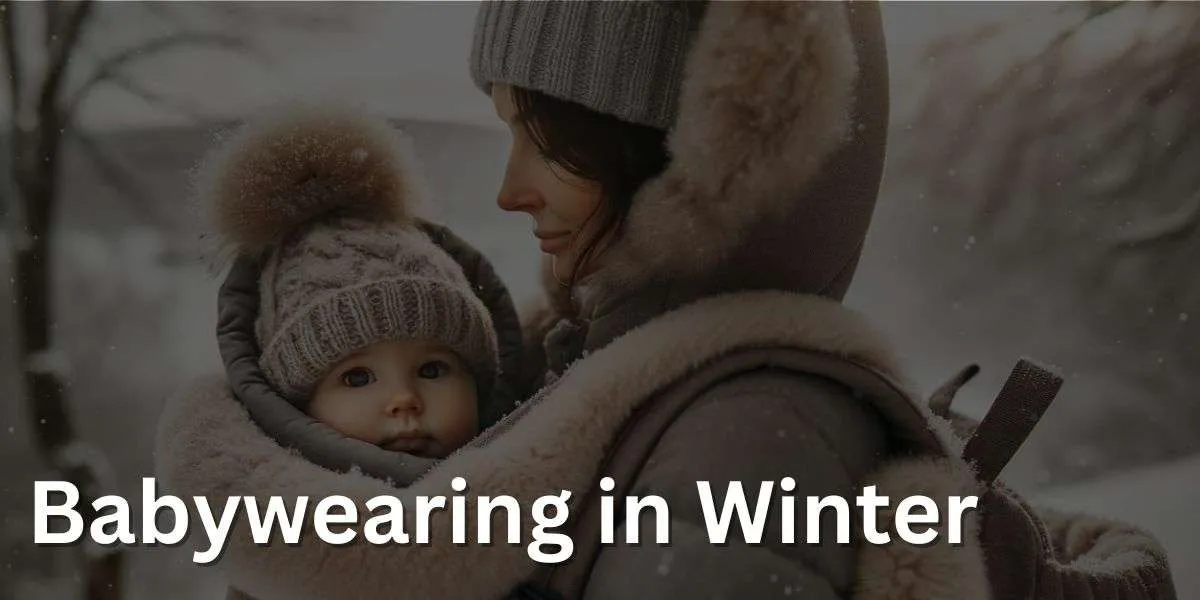Babywearing in cold weather requires extra consideration to ensure both you and your baby stay warm and comfortable without overheating. As temperatures drop, adapting your babywearing practices can make a significant difference in maintaining a cozy and safe environment for your little one.
Whether you’re facing a brisk autumn breeze or the depths of winter, this guide will help you continue the nurturing practice of babywearing throughout the colder season.
Hello, I’m Maebh Collins, a seasoned baby carrier consultant with over two decades of experience. As a certified expert in both Trageschule and Slingababy, I’ve had the privilege of assisting thousands of families in their journey to find the perfect baby carrier. Welcome to a world of comfortable, confident babywearing!
Key Takeaways: Babywearing in Cold Weather
- Dress your baby in warm, layered clothing. Multiple thin layers provide insulation while allowing flexibility to adjust to changing temperatures.
- Use a babywearing coat or cover. Specialized outerwear designed for babywearing can keep both parent and baby cozy and protected.
- Avoid overheating. Be mindful not to overdress yourself or your baby, as body heat can accumulate quickly while babywearing.
- Cover the baby’s extremities. Dress baby using hats, mittens, and booties to protect your baby’s head, hands, and keep baby’s feet warm(use thick socks) from the wind chill and extreme temperatures.
- Select carriers made from warm materials. Carriers made from thicker, warmer fabrics can provide extra warmth in cold weather.
- Keep your baby’s face uncovered. Ensure your baby’s face is not covered by fabric to maintain clear airways and prevent overheating.
- Check your baby regularly. Monitor your baby’s temperature and comfort, adjusting layers or taking breaks as needed.
- Use weather-appropriate accessories. Waterproof rain covers or wind-resistant materials can be useful in different cold weather conditions. Like car seats, don’t use a sleep sack in a baby carrier.
- Maintain a safe and ergonomic position. Ensure your baby is properly positioned and supported in the carrier, even with extra clothing and covers.
- Be cautious on slippery surfaces. Pay extra attention to footing and balance when walking on snow or ice while babywearing.
Babywearing in Winter
When it comes to babywearing in cold weather, it’s essential to dress both you and your baby appropriately. In order to maintain a comfortable and safe temperature, it’s important to understand how to layer clothing effectively.
To start with, dress your baby in a base layer, such as a onesie. This layer helps to keep their body heat close to them while also wicking away any moisture. On top of the base layer, you can add pants and a warmer top, like a sweater or fleece shirt. Remember to include socks, hats, booties, and mittens to protect their little hands and feet from the cold.
For you, it’s essential to dress in layers as well. This will not only help to keep you warm, but will also allow you to adjust your body temperature should you start to overheat. thermo-regulation is more challenging when you’re carrying an extra little passenger.
When babywearing in colder weather, it’s crucial not to overdress your baby or yourself. Overheating can be a real concern, so it’s vital to monitor your baby’s temperature regularly by feeling the back of their neck. If either of you starts to feel too warm, simply remove a layer to achieve an optimal temperature.
Choosing the Right Winter Babywearing Gear
When it comes to winter babywearing, it’s essential to choose the right gear for both you and your little one. This way, you can keep your baby warm and cozy while enjoying the colder months together. Let’s dive into some options to make your winter babywearing experience comfortable and safe.
Consider the type of carrier that works best for your needs. Three popular options are wraps, soft structured carriers, and slings. Wraps offer a snug fit and are versatile to accommodate your baby’s various stages. For example, the Front Cross Carry is great for winter babywearing as it allows you to pre-tie the wrap and quickly secure your baby before heading out.
Soft structured carriers provide proper support, avoiding baby slipping, and are easy to use. Look for carriers with non-slip winter overall options to avoid your baby getting wet in snow. Slings are a simple choice that might suit you if you’re looking for something less bulky.
Next, think about clothing. Layering is crucial when babywearing in cold weather. It’s easier to adjust your baby’s temperature by adding or removing layers than by using heavy clothing. A base layer of moisture-wicking fabric like merino wool is excellent for both you and your baby. Then, add a mid-layer of insulation like fleece, followed by an outer layer that is both wind and water-resistant.
Invest in a babywearing coat or a maternity coat with a babywearing panel. These coats are designed to accommodate your baby both in and outside of a carrier, keeping you both warm without letting any cold air in. While a babywearing coat works best, you could also use any large coat to fit both of you if it keeps you warm enough.
Proper Clothing and Accessories for Babies
When dressing your baby for cold weather, it’s essential to keep them warm and protected. Here are some helpful tips on choosing the right clothing and accessories for your little one.
Start with a comfortable cotton onesie or long sleeved shirt or undershirt. These base layers should be snug and soft against your baby’s skin, making them ideal for maintaining warmth. For infants, you can opt for a long sleeve shirt with fold-over cuffs to cover their tiny hands.
Layer a cozy sweater or vest over the base layer, followed by a pair of pants or leggings. As extremities tend to get cold quickly, add socks or booties to keep their feet warm. If you’re out and about with your toddler, it’s a good idea to choose a pair of non-slip socks for extra safety.
A properly insulated jacket or coat is essential during colder months and cold temperatures. For younger babies, a bunting is a great option. It covers their entire body and can even substitute an additional pants layer. Keep in mind that while wearing thick jackets, it’s crucial to remove bulky clothing while your baby is in a car seat to ensure it properly straps in – a car seat cover wiith easy access to the car seat harness is vital.
To protect your baby’s head from cold winds, wear a snug-fitting hat that covers their ears. In case of extreme cold or snow, you can also choose a hat with a chinstrap to ensure it stays in place and keeps baby’s neck warm. Remember babies lose a lot of heat via their head so warm layers are essential.
Don’t forget the mittens. Babies often have their hands exposed, making mittens essential for shieldings their hands from the cold. Opt for mittens with an adjustable wrist strap to keep them secure.

Safety Measures for Babywearing in Winter
When babywearing in cold weather, it’s essential to prioritize safety for both you and your little one. Here are some helpful tips to ensure a secure and warm babywearing experience:
- Keep your baby visible: Always make sure your baby’s face is uncovered and visible, which helps with monitoring their comfort and breathing. Avoid obstructing their face with fabric or scarves.
- Proper positioning: Maintain your baby in an upright position, close enough to your chest to promote heat transfer and prevent slouching. This position also reduces the risk of obstructed airways and Sudden Infant Death Syndrome (SIDS).
- Avoid using bulky clothing: Overly thick clothing, such as heavy winter coats, can prevent a secure fit in a carrier. Instead, dress your baby in layers and place a blanket over the carrier, ensuring the car seat straps are snug but not too tight.
- Watch for warning signs: Be vigilant for symptoms of frostbite, hypothermia, or overheating. A few things to look out for include: cold extremities, pale or blueish skin, excessive sweating, and shivering. Make sure to check on your baby regularly and adjust their attire accordingly.
- Proper footwear for parents: Invest in warm boots with good traction to prevent slips and falls on icy surfaces. Ensuring you have a secure footing will keep both you and your baby safe during winter walks.
Follow these safety measures to make your winter babywearing experience enjoyable for you and your little one.
Preventing Overheating in Babywearing
When babywearing in cold weather, it’s essential to strike a balance between keeping your little one warm, comfortable, and preventing them from overheating. A simple strategy to achieve this delicate equilibrium is to dress them in layers. Layering allows you to easily adjust your baby’s clothes as the temperature changes and ensure they stay cozy without getting too warm.
Start by dressing your baby in a breathable base layer such as a onesie or thin cotton pajamas. This layer will help wick away moisture and keep their skin dry, contributing to their overall comfort. Next, add a mid-layer for insulation, which can be a lightweight fleece or wool sweater. This will help trap heat without adding too much extra bulk.
Keep in mind that babies have less body fat than adults, and they may need an additional layer to stay warm compared to what you are wearing. However, avoid wrapping them in thick, heavy garments as this can lead to overheating. Instead, choose thin, breathable layers that will provide warmth without causing your baby to overheat.
Remember that it is important to always pay close attention to your baby’s comfort during babywearing. Look for signs of overheating, such as flushed cheeks, sweating, or rapid breathing. If you notice any of these symptoms, it’s time to remove a layer or unwrap your baby for a short break to cool down.
FAQS on Babywearing in Winter
How do you wear babywear in the winter?
Wearing babywear in the winter requires extra layers to keep both you and the baby warm, but not overheated. Dress your baby in warm, but not bulky, layers. A good rule is to dress the baby in one more layer than you’re wearing. Use a babywearing coat or a large jacket that can zip over both of you. Alternatively, use a specifically designed babywearing cover that fits over the carrier. Always protect the baby’s extremities with warm socks, booties, and a hat, as these areas can get cold easily.
What does a baby need to wear in winter?
In winter, a baby needs to be dressed warmly but in layers to prevent overheating. Start with a base layer like a bodysuit or thermal pajamas, then add a warm top layer like a fleece suit or a sweater and pants. Always include a hat to protect their head and ears from the cold, and socks or booties for their feet. If going outside, consider a snowsuit or bunting bag appropriate for the temperature, and mittens to keep their hands warm.
What should baby wear to sleep in winter?
For sleeping in winter, dress your baby in warm but breathable layers. A one-piece sleeper or long-sleeved pajamas with footies can be ideal. Depending on the temperature of the room, you might add a wearable blanket or sleep sack for extra warmth. Avoid loose blankets, pillows, and plush toys in the crib to reduce the risk of Sudden Infant Death Syndrome (SIDS). The room should be kept at a comfortable temperature – not too hot or too cold.
What should baby wear in a car seat in winter?
In a car seat during winter, the baby should be dressed in thin layers to ensure the car seat harness fits snugly. Bulky coats and snowsuits can create too much space under the harness, increasing the risk in the event of a crash. Dress the baby in thin, warm layers like fleece, and after buckling them into the seat, place a blanket or a car seat cover over the harness for additional warmth. The cover should not go under the baby or between the baby and the harness.











